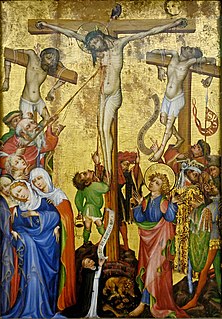 W
WCrucifixion is a method of punishment or capital punishment in which the victim is tied or nailed to a large wooden beam and left to hang perhaps for several days, until eventual death from exhaustion and asphyxiation. It was used as a punishment by the Romans. Crucifixion has been used in parts of the world as recently as the twentieth century.
 W
WCrucifixions and crucifixes have appeared in the arts and popular culture from before the era of the pagan Roman Empire. The crucifixion of Jesus has been depicted in religious art since the 4th century CE. In more modern times, crucifixion has appeared in film and television as well as in fine art, and depictions of other historical crucifixions have appeared as well as the crucifixion of Christ. Modern art and culture have also seen the rise of images of crucifixion being used to make statements unconnected with Christian iconography, or even just used for shock value.
 W
WCrucifixion in the Philippines is a devotional practice held every Good Friday, and is part of the local observance of Holy Week. Devotees or penitents called magdarame in Kapampangan are willingly crucified in imitation of Jesus Christ's suffering and death, while related practices include carrying wooden crosses, crawling on rough pavement, and self-flagellation. Penitents consider these acts to be mortification of the flesh, and undertake these to ask forgiveness for sins, to fulfil a panatà, or to express gratitude for favours granted. In the most famous case, Ruben Enaje drives four-inch nails into both hands and feet and then he is lifted on a wooden cross for around five minutes.
 W
WThe term crux simplex was invented by Justus Lipsius (1547–1606) to indicate a plain transom-less wooden stake used for executing either by affixing the victim to it or by impaling him with it. He thus distinguished two types of crux simplex: the crux simplex ad affixionem and the crux simplex ad infixionem.
 W
WDescriptions in antiquity of the execution cross, whether by Christians or non-Christians, present the instrument ordinarily used in putting people to death by crucifixion as composed of two wooden pieces. Whether the two pieces of timber of the normal execution cross were permanently conjoined or were merely put together for the purpose of the execution is not stated.
 W
WRuben Enaje is a Filipino carpenter, sign painter, and former construction worker. He is noted for being crucified 33 times as of 2019.
 W
WMattio Lovat was an Italian who made two self-crucifixion attempts, in 1803 and 1805 in Venice, Italy, respectively. In July 1805, Mattio, on his second self-crucifixion attempt at public streets, was successful, an act that landed him on hospital. He died the following year at the San Servolo Island asylum.